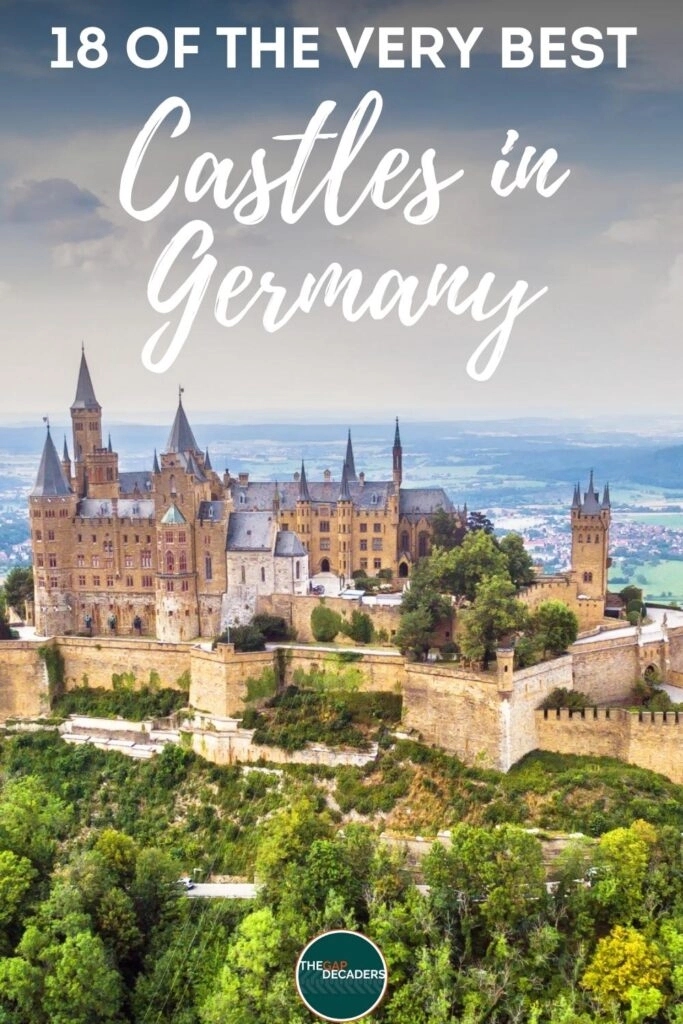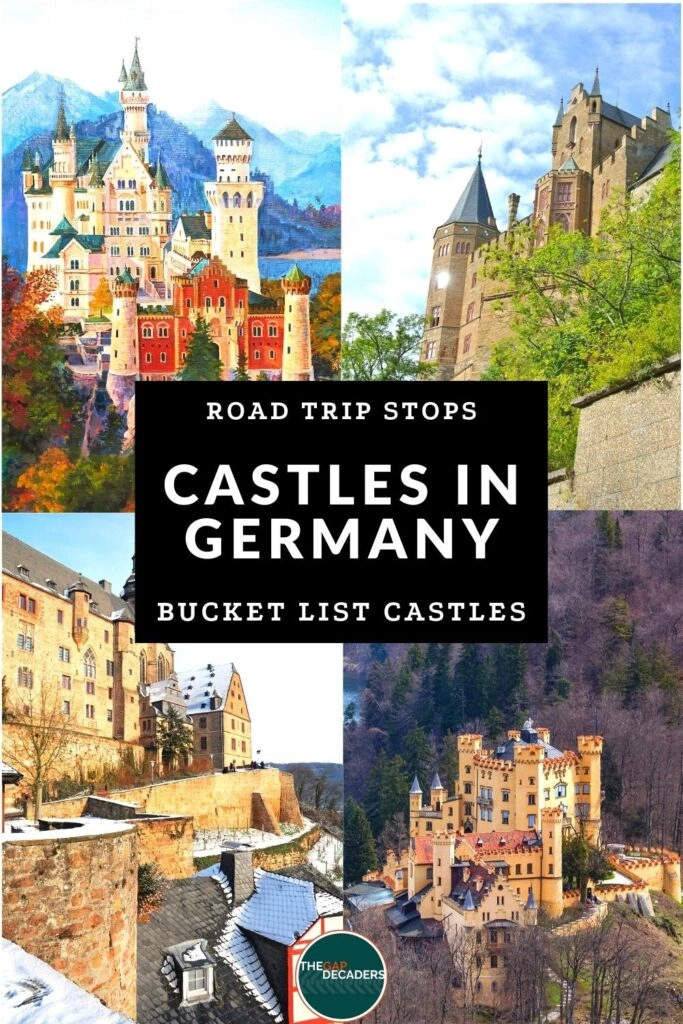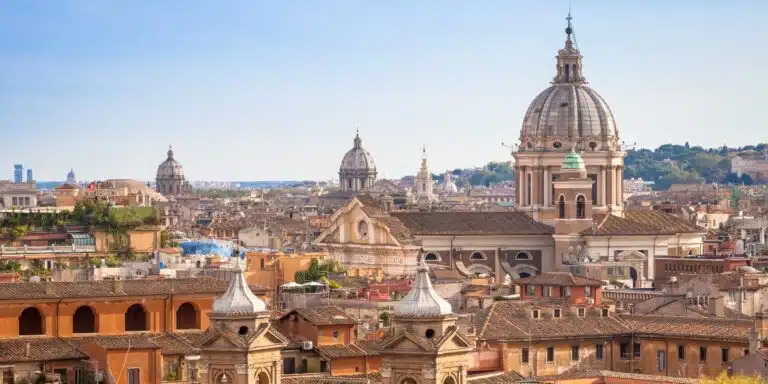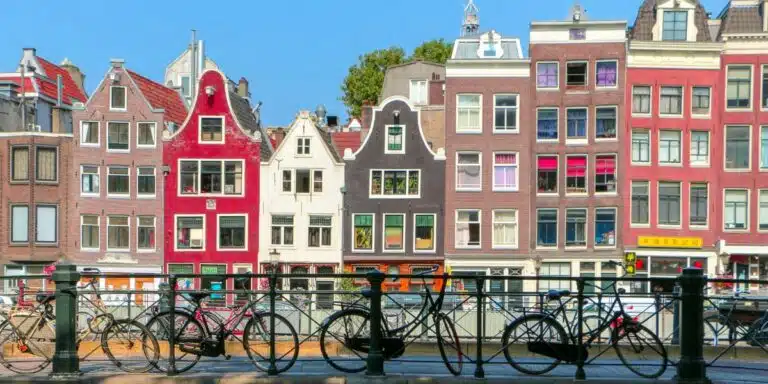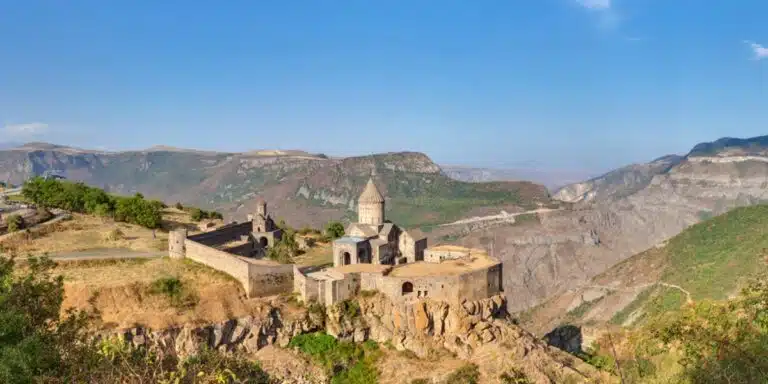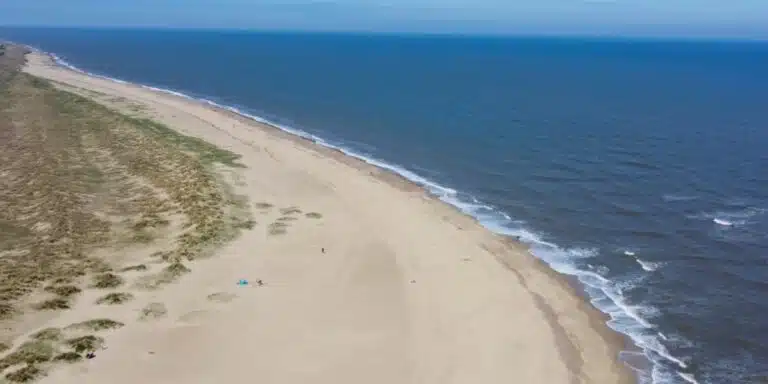This post may contain affiliate links, from which we earn an income. Click here to read our affiliate policy.
Germany is a country with a rich history and culture, and it is home to some of the most beautiful castles in the world. If you are looking for an enchanting road trip destination, add Germany to your list!
Known for its fairy tale castles, Germany is home to over 20,000 of them! From the most famous of all, Neuschwanstein, to medieval fortified castles like Marburg, and elegant royal palaces like Moritzburg, these historic buildings are dotted across Germany’s diverse landscape, and many of them are open to the public.
We’ve rounded up the top eighteen, which we think capture the essence of what makes a magical German castle. Soaring turrets, medieval drawbridges, fascinating stories, and Disney-esque design all get our vote! Whether you’re a history buff or simply looking for a stunning vacation spot, these castles are sure to impress!
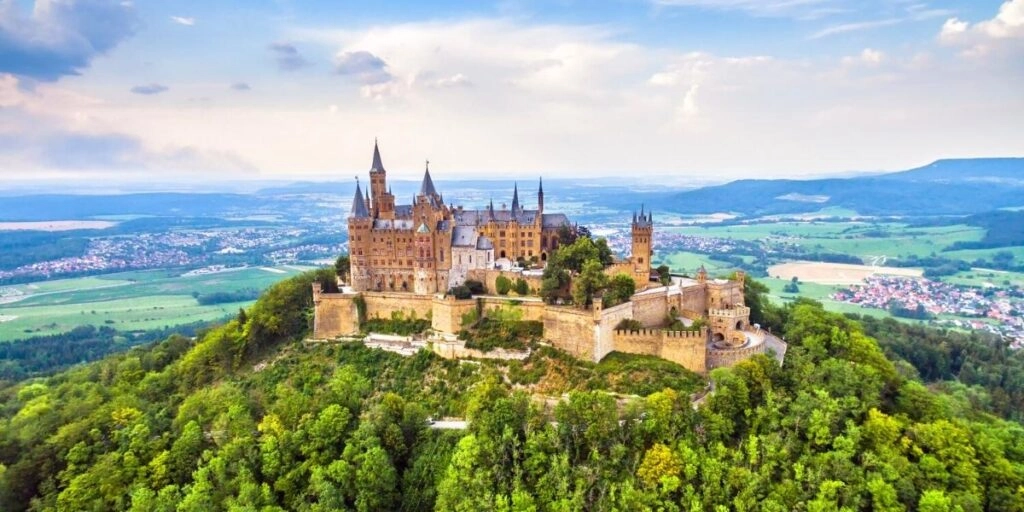
Is this your first time visiting Germany? Get all the information you need in our Germany Travel Guide, including what to pack, the best time of year to go, getting there and practical tips to help you have the best trip!
Neuschwanstein Castle
Sitting atop a rugged cliff overlooking the picturesque Bavarian countryside, Neuschwanstein Castle is one of Germany’s most iconic landmarks.
This magical castle was commissioned by mad King Ludwig II of Bavaria as a retreat from his courtly duties, and its ornate facade, impressive architecture, and clever inventions have attracted visitors from around the world since 1884.
Despite being set in such a serene and unspoiled location, Neuschwanstein Castle is anything but simple. With soaring spires, intricate stained glass windows, and sprawling courtyards filled with lush landscaping, this breathtaking palace has inspired countless artworks and has been featured in books, movies, television shows, and even music videos!
Photographers will want to head for Marienbrücke, the Bridge of Our Lady. The beautiful bridge spans a deep gorge across the River Pollat and has amazing views across to the castle, especially in the morning light, and well before the day trips from Munich arrive.
One of the most famous castles in Germany, and truly a must-see on any Deutsche Alpenstrasse road trip in Bavaria, Schloss Neuschwanstein is an unforgettable experience that you won’t want to miss.
RELATED POST – Six Unmissable Germany Road Trip Routes
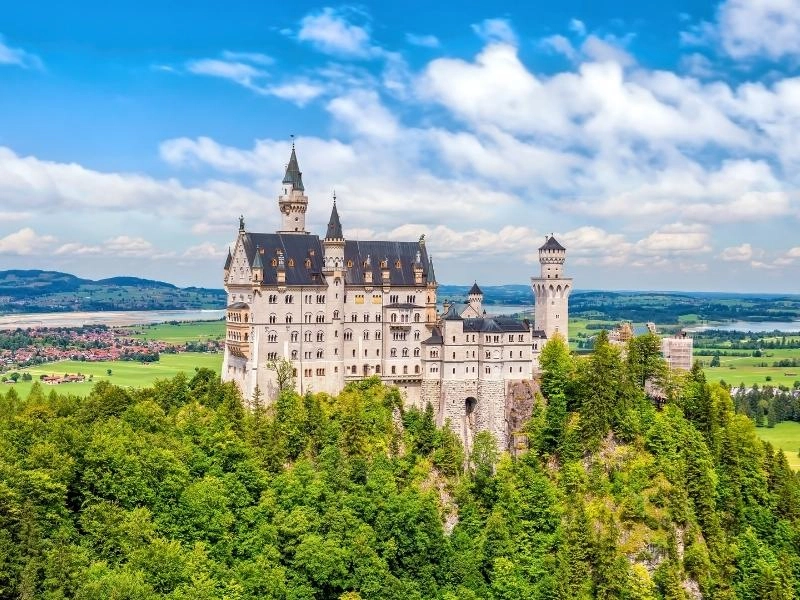
Heidelberg Castle
Heidelberg Castle is a must-see for anyone who finds themselves in southwest Germany. The imposing red sandstone structure is situated on the Königstuhl hillside overlooking the old town of Heidelberg and the beautiful River Neckar.
The castle has a long and storied history, having been built in the 13th century and serving as a residence for German royalty for centuries. The castle was only been partially rebuilt since its demolition in the 17th and 18th centuries, and the ruins are among the most important Renaissance structures north of the Alps.
Today, it is one of the most popular tourist attractions in the country, drawing visitors from all over the world. The castle grounds are stunning, and there are regular concerts, performances, and festivals held in the courtyard, and in summer there are huge fireworks displays. There is even a tavern located within the castle walls that serves up traditional German fare.
For the best views of the city and the easiest route to the castle, take the funicular railway that set off on its first journey back in 1890. The historic funicular connects four stations in Heidelberg – hop off at the new funicular for the final ride to the castle.
RELATED POST: Driving from UK to Germany: Best Routes, Costs & Tips
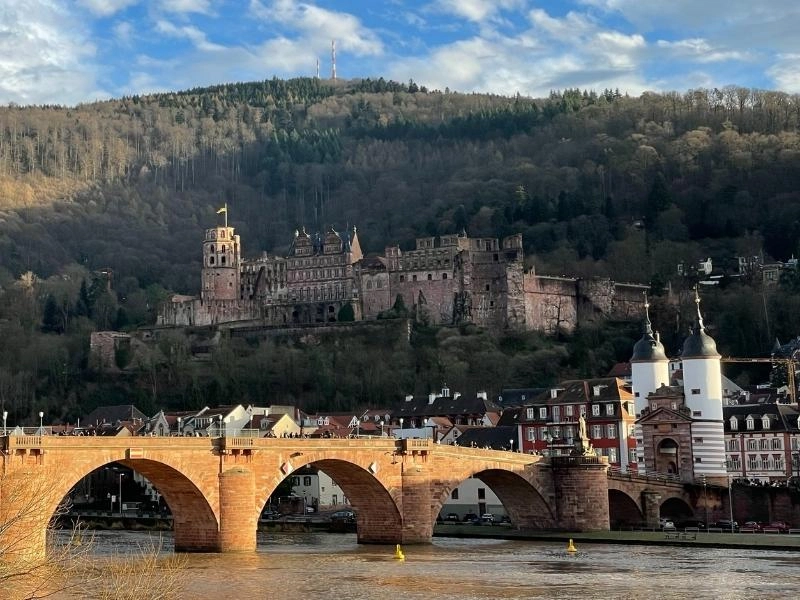
Hohenzollern Castle
If you’re looking for a fairytale castle experience, look no further than Hohenzollern Castle in Germany.
Nestled in the picturesque Swabian Alps of Baden-Württemberg, the castle dates back to the 11th century and was the seat of the Brandenburg-Prussian rulers, Prussian kings, and Germany’s kaisers, making it the seat of one of Europe’s most powerful ruling families.
The castle is situated on a mountaintop and can be accessed via a footpath or a shuttle bus. Once you reach the top, you’ll be greeted by breathtaking views of the surrounding countryside.
The castle itself is equally impressive, with its towering spires and imposing facade. Inside, you’ll find a wealth of historical artifacts and works of art scattered among the 140 rooms.
The interior design is truly opulent, with a gilded coffered ceiling, beautifully detailed marquetry floors, and portraits of Prussian royals. Highlights include the library with its fabulous murals, the King’s bed chamber, a family tree room, and the Queen’s room, also known as the Blue Salon.
There are always lots of events going on in and around the castle, and in winter, one of the best German Christmas markets is held here in the courtyard.
If you’re looking for a truly magical castle experience, Burg Hohenzollern is definitely worth a visit.
RELATED POST: The Best of the Black Forest: Highlights & Hidden Gems
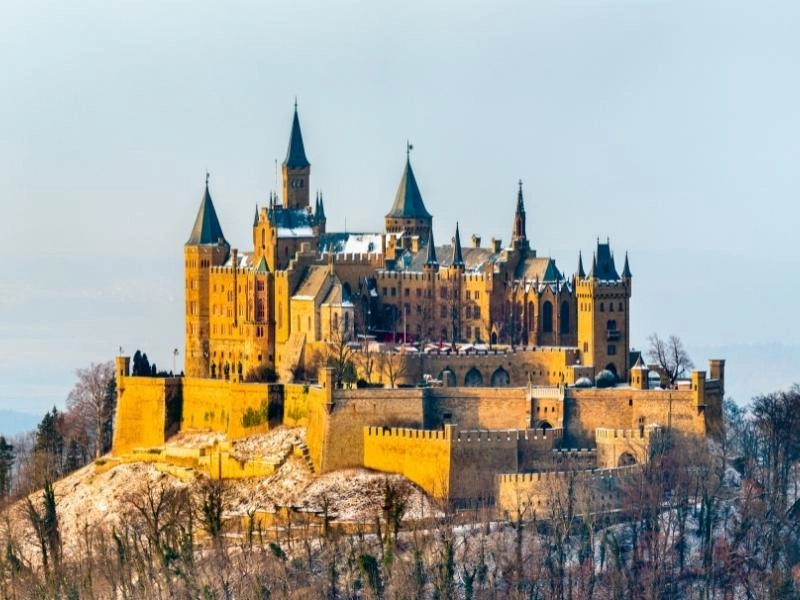
Lichtenstein Castle
The gothic revival Lichtenstein Castle is a magical place located in Germany. The castle looks like it is straight out of a medieval fairytale, perched impossibly on a rocky crag, with its round tower, steep walls, moat, and drawbridge.
Built in 1840 by Count Wilhelm of Württemberg on the historic foundation walls of a medieval knights’ castle, Schloss Lichtenstein is an homage to the middle ages.
Visitors can tour the castle and learn about its history. Highlights include the small chapel with precious glass paintings from the 15th and 16th centuries, the drinking room with mural paintings that tell the stories of local people, and the knight’s hall with its wood paneling and finely painted ceiling.
At the end of the tour, there is the Castle Tavern and Old Foresters Lodge where you can enjoy freshly prepared traditional German food.
Schloss Lichtenstein is a wonderful place to visit and learn about German culture and history.
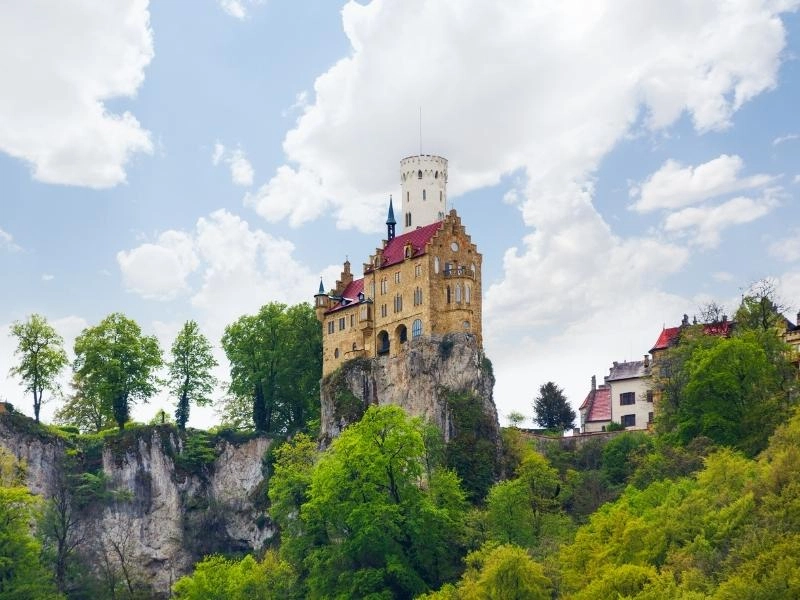
Schwerin Castle
Schwerin Castle is an elegant castle located in the city of Schwerin, the capital of Mecklenburg-Vorpommern, and one of Germany’s most northerly castles. It is situated on an island in the middle of Lake Schwerin and has a beautiful storybook appearance with its turreted towers and ornate stonework.
This castle has a long history, as far back as the Slavic Middle Ages of the 10th century when the ancestors of the Mecklenburg princes built a fortified castle here, and some artifacts of this early period still remain.
In the 16th century, the fort became a palace and in 1837, Friedrich Franz II commissioned a complete reconstruction of the historic site, with only some parts of the building dating from the 16th and 17th centuries retained.
Regarded as one of the most important architectural works of romantic historicism in Europe, it is designated to become a UNESCO World Heritage Site. The castle known as the ‘Neuschwanstein of the North’ serves as the residence of the Mecklenburg-Vorpommern state parliament, whilst other parts are open for tourists.
Outside and inside Schloss Schwerin is largely original and has been opened up as a museum in many areas, and houses a large collection of historic art and period furniture.
RELATED POST: 24 Hours in Hamburg – Itinerary, Map & Travel Tips
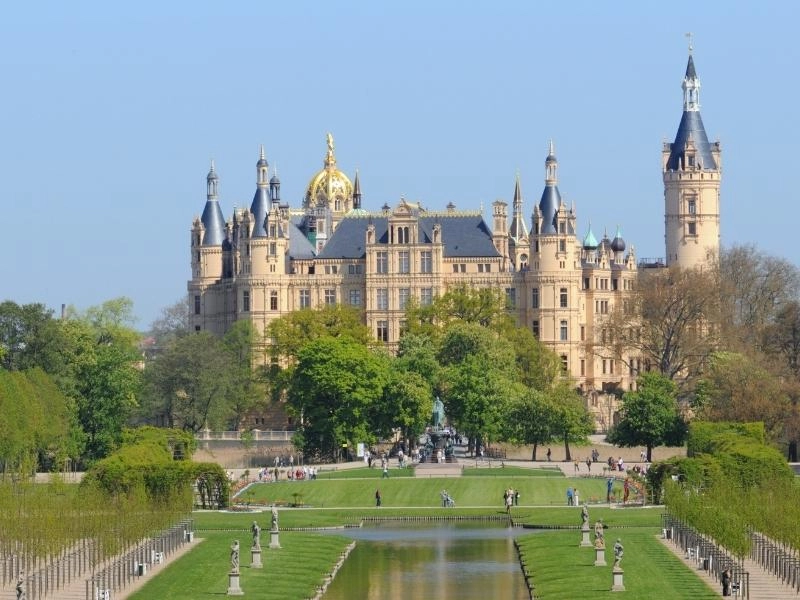
Moritzburg Castle
Located in the stunning town of Moritzburg is the famous magical castle known as Moritzburg Castle. This beautiful fairytale castle is truly a sight to behold, with its picturesque turrets and sprawling gardens. Whether you visit during the bright spring months or dreamy summer nights, this enchanting castle never fails to mesmerize you.
Built in the Baroque style in the late 18th century, Moritzburg Castle boasts intricate detailing in every aspect of its design, from ornate carvings to elaborately painted walls.
But even more impressive than its exterior beauty is the exquisite artwork within the castle itself. From intricate frescoes adorning the walls of its vast banquet halls to detailed sculptures found in its chambers and courtyards, this magical castle is a true treasure trove of art and culture.
If you find yourself admiring castles on your travels through Europe, then be sure not to miss out on this one-of-a-kind masterpiece. With its remarkable architecture and breathtaking interiors, Schloss Moritzburg is a must-visit destination that will leave you absolutely spellbound.
RELATED POST: Europe Road Trip – 24 Incredible Routes
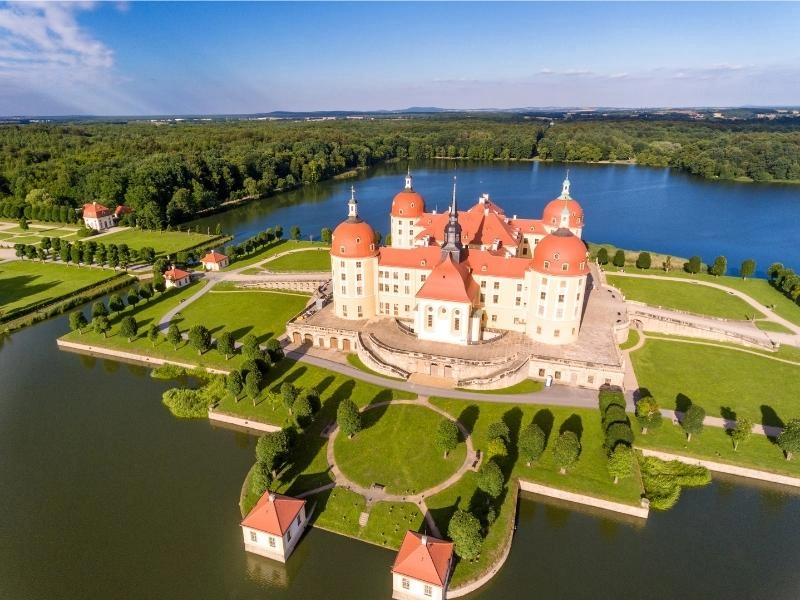
Sanssouci Palace
Sanssouci Palace is a magical castle located in Potsdam, near Berlin. The castle is situated on a vineyard-covered hill and is surrounded by stunning gardens.
Schloss Sanssouci was built by King Frederick the Great in the 18th century and was designed to be a place of relaxation and escape from the hustle and bustle of court life.
Today, the castle is open to visitors and is well worth a visit if you’re in Berlin. The castle grounds are beautiful and there is something truly magical about walking through the halls and rooms of this historic building.
If you are looking for a little bit of magic in your life, be sure to add Sanssouci Palace to your travel list.
RELATED POST: Berlin in One Day – Itinerary, Map, Tips & Guide
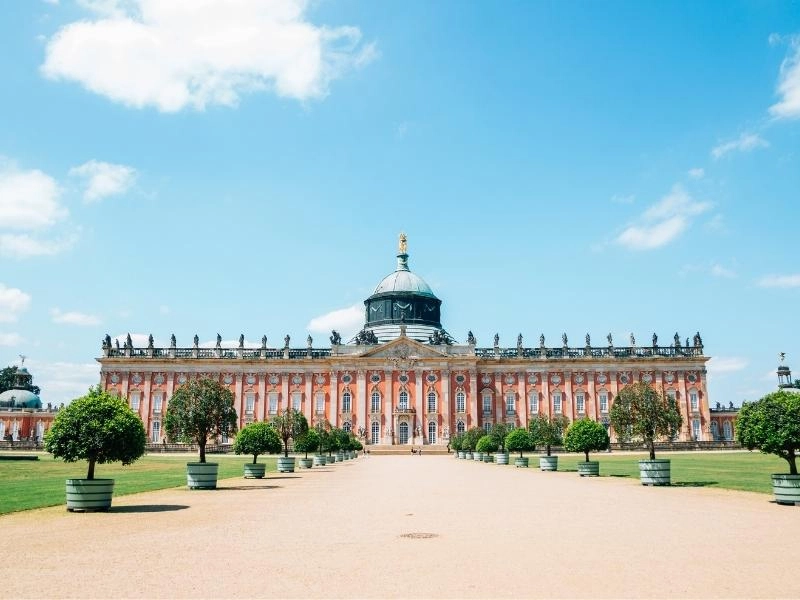
Imperial Castle of Nuremberg
One of the most important medieval fortresses in Europe, the Imperial Castle of Nuremberg is a group of medieval fortified buildings that dominate the historical center of the city. Home to German kings and emperors for more than 500 years, the castle was first mentioned as a royal property in 1050, and it became a major royal residence throughout the time of the Holy Roman Empire in Germany.
After the dissolution of the Holy Roman Empire in 1806 and the incorporation of Nuremberg into the Kingdom of Bavaria, the castle found new interest as a monument of German history.
Kaiserburg Nürnberg suffered serious damage in World war II but was reconstructed, and still looks much as it did through the centuries. There is a lot to see in the castle including the Pentagonal Tower and the Kaiserburg, both of which date from the 11th century. The chapel, the Sinwell Tower, and the Deep Well, which reach more than 50 meters into the rock below, all date from the 13th century.
RELATED POST: Beautiful Cities in Germany: 27 Picturesque Cities to Visit
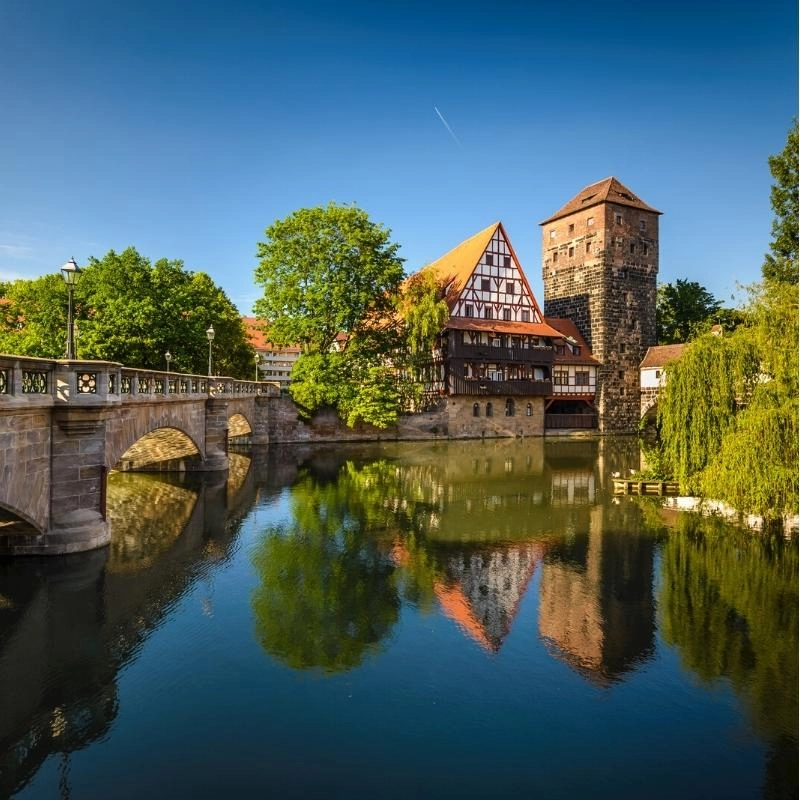
Wernigerode Castle
Built in the Middle Ages as a place of safety for emperors and their entourages during hunting trips in the Hartz Mountains, Wernigerode Castle was remodeled into a Renaissance fortress in the 16th century.
Badly damaged in the Thirty Years War, a local nobleman completed a Baroque conversion in the late 17th century, turning the castle into a romantic residential home. Further 19th century renovations ensured that the castle became a leading building of North German historicism.
The remains of these styles can be seen in the Renaissance staircase tower and Gothic arched windows in the courtyard. Within the castle’s 50 rooms you’ll find lavish decorations including inlaid floors, paneled walls, and marble fireplaces. Outside are several beautifully laid out gardens, perfect for strolling on a warm afternoon.
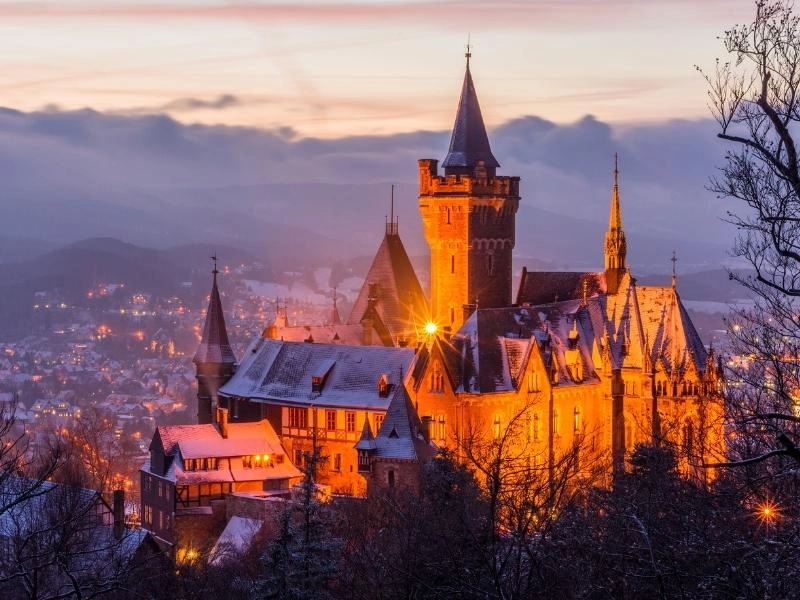
Eltz Castle
Another Schloss from a fairytale, Eltz Castle has all the elements – Rapunzel like fairy tale towers, half-timbered detail, pointy roofs, and access over a narrow bridge through a stone arch, all set atop a rocky promontory surrounded by dense forest. Your first sight of Burg Eltz is unforgettable!
Located between the rivers Eifel, Moselle, and Rhine in Rhineland-Palatinate, the castle has been owned by the same family since its origins in the 12th century. Lovingly maintained and restored, with beautiful interiors and much of its original historic furnishings, it is considered one of Germany’s best examples of a medieval castle.
Enlarged over the centuries, by the mid-1600s the castle had reached its present size and today, the incomparable architecture from the Middle Ages makes this castle one-of-a-kind.
Highlights of a visit include the Knights Hall, and its suits of armor, an original 15th century kitchen, the armory, and the treasury. The latter houses one of Germany’s most important private collections of historic artworks, including gold and silver, jewelry, and other treasures.
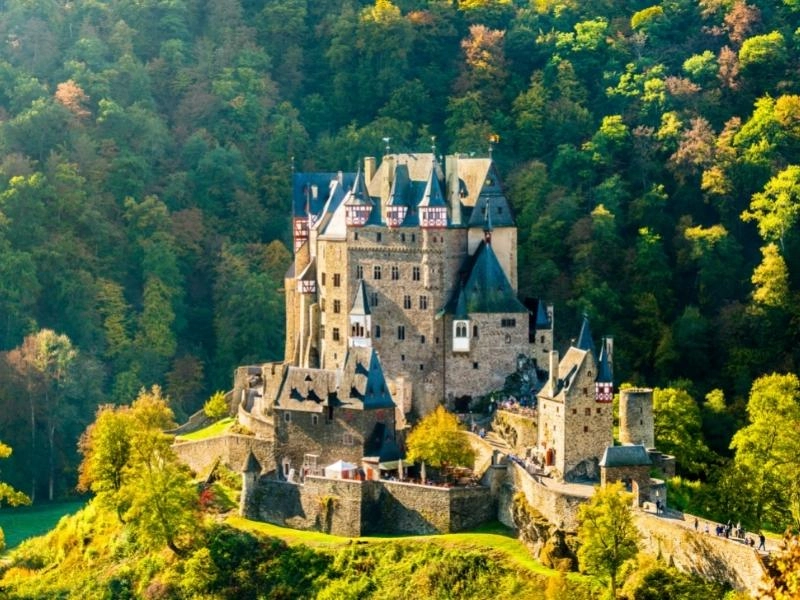
Weesenstein Castle
Towering over the Mueglitz Valley near Pirna in Saxony for 800 years, Weesenstein Castle has been extensively restructured, layer by layer to align the architecture with the contemporary style of the day.
The earliest layer was a 14th century military fortification built at the highest defensive position, and subsequent additions descend the hill, until the final construction of a royal residence at the bottom, in the 18th and 19th centuries.
The Gothic and classicist elements of Schloss Weesenstein have created a unique castle that is notable in Saxony, where there are over 130 castles! Its historic staircase has lots of nooks and crannies to be explored, including a stable on the fifth floor. Rooms hung with precious tapestries are located one floor beneath the cellar, and every fifth window is merely painted onto the façade of this fascinating castle.
Below the castle stretches the River Müglitz, which flows through a park of beautiful formal gardens, including a fragrant rose garden, sparkling fountains, and a tea house.
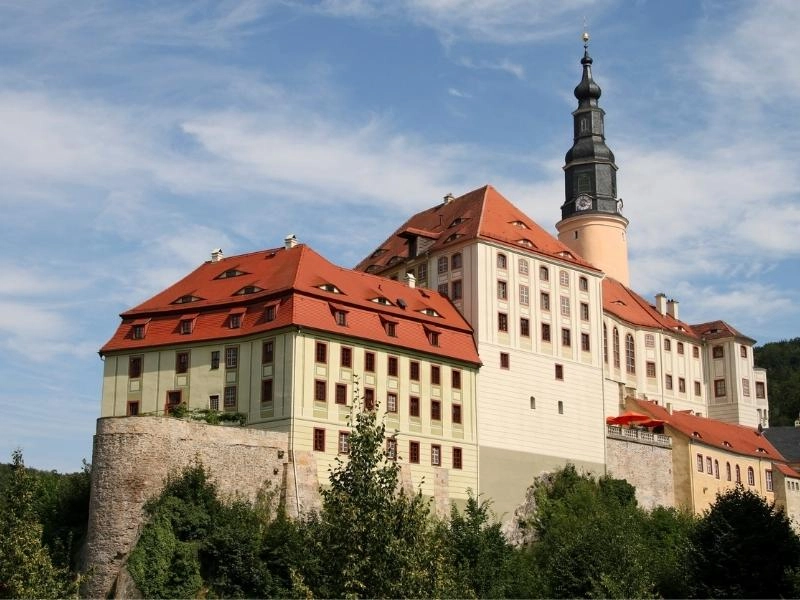
Hohenschwangau Castle
Located on an opposite crag to Neuschwanstein, Hohenschwangau Castle is more lived-in and historic, offering an excellent look at Ludwig’s life, but with fewer crowds.
Originally built in the 12th century, Schloss Hohenschwangau was ruined by Napoleon in 1743. The Bavarian Crown Prince, later King Maximilian II, father of King Ludwig II, bought the castle and began rebuilding according to the original plans, and today you see it as it looked in 1836. It was here that Ludwig grew up, in surroundings inspired by romantic legends of chivalry and knighthood.
Inside the neo-gothic exterior, the walls of the beautifully painted rooms are slathered with the epic myths and exotic decorations of 19th-century Romanticism. Outside, Queen Marie of Bavaria created an alpine garden filled with symbols of romantic stories, including a fountain in the shape of a water-spouting swan.
RELATED POST: Romantic Road Germany: Itinerary, Map & Tips
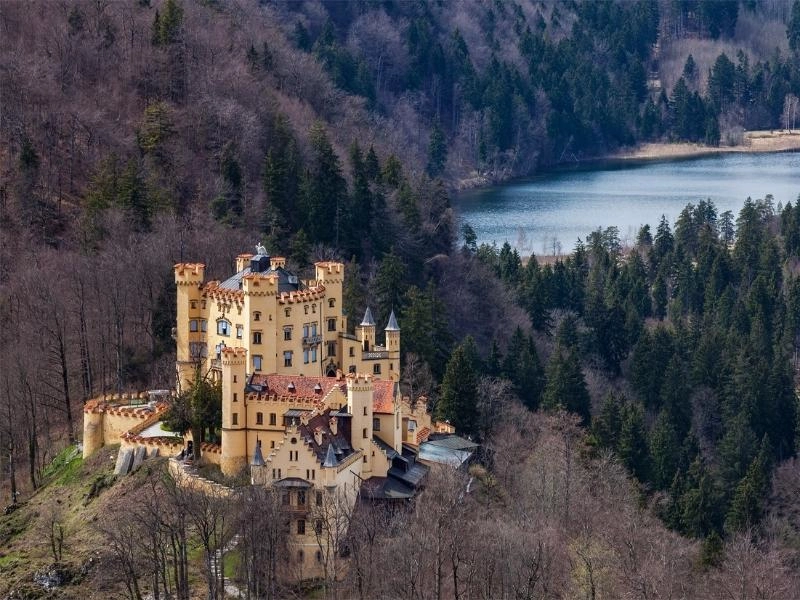
Schönfels Castle
High on a rock spur above a small medieval village between Zwickau and Reichenbach in Saxony, Schonfels Castle dates back to around 1200CE and was built to help establish new settlements in the borderlands under Emperor Friedrich I. With its moat, ramparts, and fortified buildings, Burg Schönfels is one of the best-preserved fortified castles in Germany.
Burg Schonfels was last renovated during the 15th and 16th centuries, in the late Gothic and Renaissance style, which largely shaped the appearance of the castle today, and includes a well-preserved surrounding rampart and moat, outer bailey, lower bailey and main bailey with keep.
Visit the museum and take a tour to discover the historic rooms, such as the late Gothic plank room with keel arch door, and the chapel with its unique wooden organ. For panoramic views of the surrounding countryside, climb the round tower high above the castle.
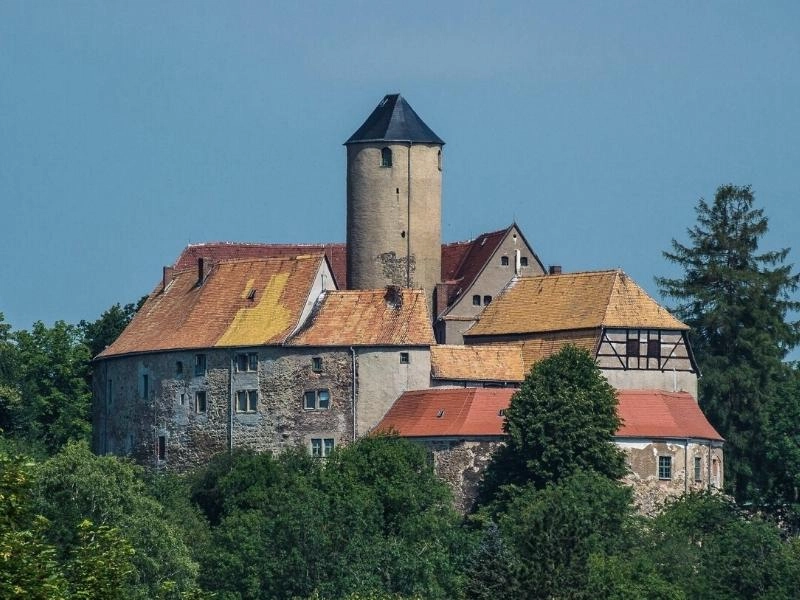
Marburg Castle
Sitting above the pretty town of Marburg in Hesse is the charming Marburg Castle, also known as Landgrafenschloss Marburg. The building originally on this site can be dated to around 1000 BCE and is thought to be one of Germany’s earliest hillforts.
The castle that overlooks the town today dates from the 13th century and was a principal residence of the Landgraves of Hesse until 1604.
Many visitors come to Marburg on a road trip of the German Fairy Tale Route. The famous brothers Grimm studied at the university here, and the castle is known to have inspired some of their stories.
The Museum of Cultural History in Marburg offers castle tours which include special rooms in the castle that are steeped in history. Highlights include the magnificent Fürstensaal, considered one of the most beautiful secular Gothic halls in Germany, and the frescoed medieval castle chapel.
RELATED POST: Deutsche Märchenstraße: Germany’s Fairy Tale Road
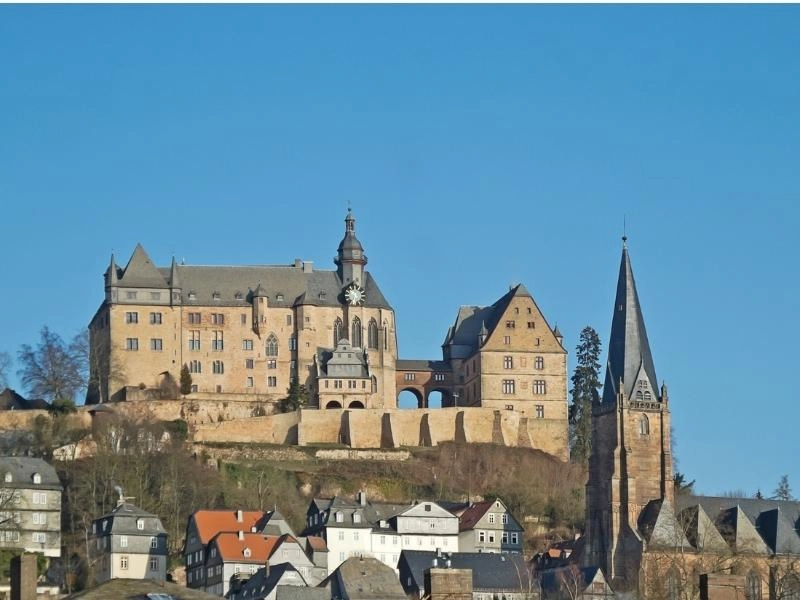
Linderhof Palace
The smallest and simplest of King Ludwig II’s castles is the exquisite Linderhof Palace, set in the woods fifteen minutes from Oberammergau, the gorgeous Bavarian village famous for the once-in-a-decade Passion Play.
Linderhof is the only one of his ambitious castles that Ludwig lived to see completed, and where he spent the last eight years of his life as a recluse.
Linderhof is sited where the Königshäuschen or royal cottage stood, which Ludwig would visit on hunting trips with his father, King Maximillian II of Bavaria. When Ludwig became King in 1864, he inherited the royal cottage, and in 1869 began enlarging the building.
In 1874, Ludwig demolished the cottage and rebuilt it, adding three new rooms and the staircase to the U-shaped complex, and cladding the wooden exterior with stone façades. The building was designed in the style of the second Rococo period and the construction costs ran well over eight million marks.
Although Linderhof is much smaller than Versailles, it is clear that the palace of the French Sun-King Louis XIV was its inspiration. Surrounded by fountains and sculpted Italian-style gardens and grottos, the interiors are sumptuously decorated.
Highlights are the Hall of Mirrors which was used as a drawing room, the royal bedchamber, and the dining room, where Ludwig usually dined alone but demanded the table be laid for four imaginary people, whom he talked to during his meal!
RELATED POST: Visit Zugspitze Germany – Find Out How!
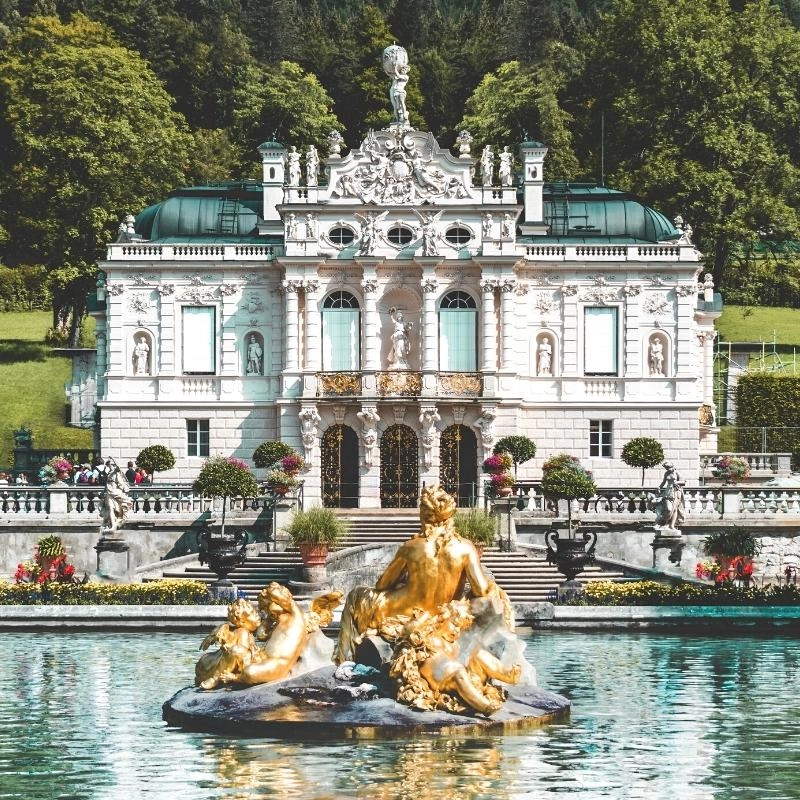
The Marksburg
One of the most important landmarks of the Upper Middle Rhine Valley UNESCO World Heritage Site, The Marksburg castle is the only one of the 40 or so hill castles along this stretch of the river between Bingen and Koblenz that has never been destroyed or fallen into disrepair.
First mentioned in 1231, the fortress was built high above the river and used for protection rather than as a residence for royal families. It has a striking example of a bergfried or tall tower designed as a butter-churn tower, in which the upper section has a smaller width than the lower section.
The castle’s builders and owners were amongst the most powerful families of the day. When Die Marksburg passed to the Landgraves of Hesse in 1479, they turned it into a fortress, adding ramparts and batteries to accommodate artillery.
After a chequered history, the castle was sold for a symbolic price of 1,000 Goldmarks to the German Castles Association which had been founded a year earlier as a private initiative to preserve castles in Germany. The Marksburg has been the head office of this organization since 1931.
Highlights of a visit are entering through a trio of medieval gateways and climbing the Riders Stairway, a winding series of steps carved from the bedrock in a shallow series that were designed to be ascended on horseback. Follow this with medieval cellars, armaments, a kitchen with a herb garden and 14th century chapel with painted walls and ceilings, and the final surprise; climbing the ancient tower for panoramic views across the Rhine River.
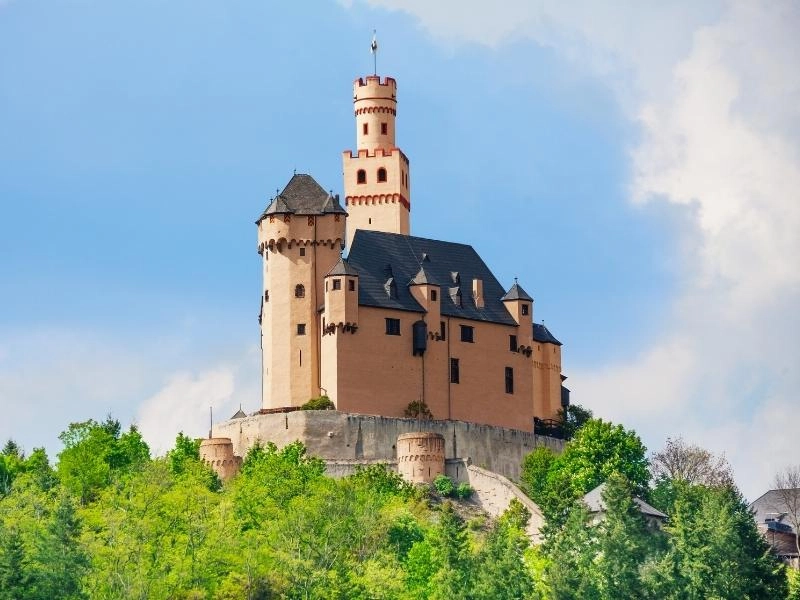
Reichsburg Castle
Soaring over the Mosel town of Cochem, the medieval Reichsburg Castle (sometimes called Cochem Castle) is simply breathtaking. Heavily damaged in 1688, the Imperial Castle of Cochem was overrun by French King Louis XIV’s troops in the course of the Nine Years’ War, and the following year, they destroyed it.
It lay in ruins until 1868, when it was bought for 300 Goldmark and lovingly restored in the neo-gothic style associated with German castle romanticism in the 19th century, and since 1978 it has been owned by the town of Cochem.
In addition to guided tours in multiple languages, visitors can enjoy a medieval evening meal known as ‘the Knights Feast’, complete with minstrels and serving maids. In summer, a medieval festival includes a market of local crafts and traditional foods, with musicians playing period instruments and dressed in period costumes.
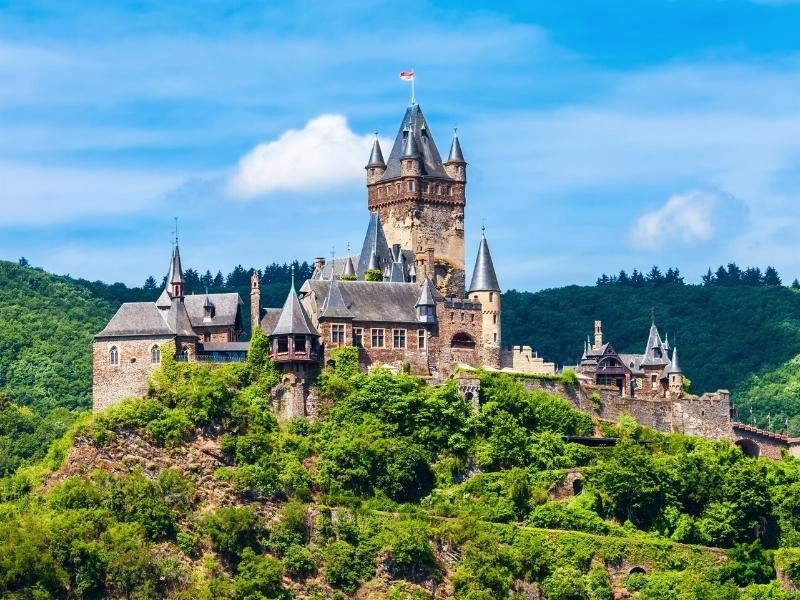
Wartburg Castle
Perched 400 meters above the forested Thuringia landscape, UNESCO Wartburg Castle stands as a monument to the cultural history of Germany, Europe, and beyond, for it was here that Martin Luther made his translation of the Bible, where Saint Elizabeth of Hungary, of the legend of The Miracle of the Roses, lived and worked, and where King Ludwig II took inspiration for Neuschwanstein.
Although the Schloss Wartburg of today still contains substantial original structures from the 12th to the 15th century, much of the interior dates back only to the 19th century. The castle’s original foundation was laid in about 1067 and became one of the most important princes’ courts in the German Reich. In 1320, substantial reconstruction work was done after the castle had been damaged in a fire caused by lightning in 1317 or 1318.
Thereafter, the castle fell increasingly into disuse and disrepair, especially after the end of the Thirty Years’ War when it had served as a refuge for the ruling family until reconstruction was ordered in 1838, and it is this castle we see today.
You must book a guided tour to visit Wartburg Castle’s lavish interiors, which include beautiful tapestries, the ornate decoration of the Festsaal (Festival Hall), lavish golden mosaics, and medieval musical instruments. The residential rooms are spread over three floors and are considered the best-preserved example of late Romanesque architecture north of the Alps.
The true highlight of the tour is the barely furnished room of Martin Luther. Look for the ink spot on the wall – it is said that it was left by Luther after he threw an inkwell at the devil.
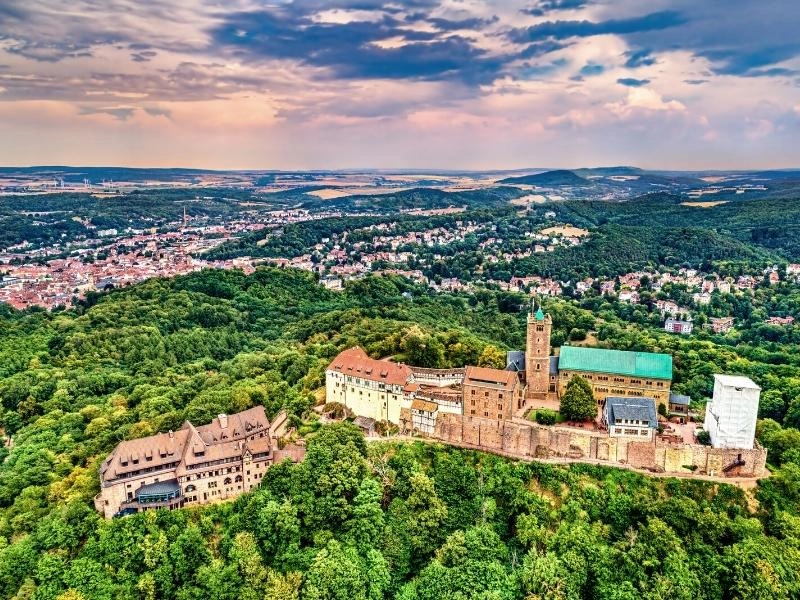
Map of German Castles
How to use this map – Use your fingers (or computer mouse) to zoom in and out. Click or touch the icons to get more info about a place, and click the arrow in the box top left to open the index. To add to your own Google Maps account, click the star next to the title of the map.
Looking for more European travel inspiration? Check out these top posts…
20 Best Cities in Italy to Visit & Fall in Love With
Most Instagrammable Places In Amsterdam
Things to Do in Armenia: Top Must-See Sights & Activities
Ferry from Spain to Morocco: Best Options & Top Tips
Norfolk England Beaches: Ultimate A-Z Guide
Beautiful Places in Morocco: 25 Most Photogenic Destinations
Love it? Pin it!
